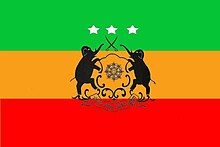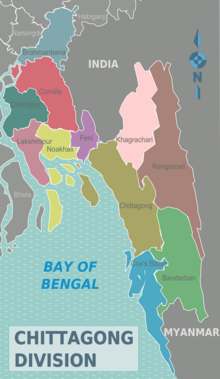𑄌𑄋𑄴𑄟𑄳𑄦 | |
|---|---|
 | |
 Chakma lady in traditional attire . | |
| Total population | |
| ≈ 800,000 (2011–2022) | |
| Regions with significant populations | |
| Bangladesh,[1] India[1] and Myanmar | |
| 529,271 (2022)[2] | |
| 228,281 (2011)[3] | |
| Mizoram | 92,850 |
| Tripura | 84,269 |
| Arunachal Pradesh | 47,073 |
| Assam | 3,166 |
| West Bengal | 175 |
| Meghalaya | 159 |
| Nagaland | 156 |
| 43,100[4] | |
| Languages | |
| Chakma | |
| Religion | |
| Related ethnic groups | |
| Daingnet, Tanchangya, Rakhine, Bamar | |


The Chakma people or Changhma people (Chakma: 𑄌𑄋𑄴𑄟𑄳𑄦), are an ethnic group from the eastern-most regions of the Indian subcontinent and Western Myanmar. They are the largest ethnic group of the Chittagong Hill Tracts region of southeastern Bangladesh, and the largest in the Chakma Autonomous District Council of Mizoram, India. Significant Chakma populations are found in the northeast Indian states of Arunachal Pradesh, Tripura and Assam.
The Chakma possess strong ethnic affinities to Tibeto-Burman-speaking groups in Northeast India. Because of a language shift in the past to consolidate power among the tribes, they adopted an Indo-Aryan language Chakma, which is closely related to the Chittagonian language, predominant near the areas in which they live.[5] Most modern Chakma people practice Theravada Buddhism, due to 19th-century reforms and institutionalisation by Queen regnant Rani Kalindi. In Myanmar, Chakma people are known as Daingnet and are one of the 135 officially recognised ethnic groups there.[citation needed]
The Chakmas are divided into 31 clans or gozas.[5] The community is headed by the Chakma Raja, whose status as a tribal head has been historically recognised by the government of British India and the government of Bangladesh.
- ^ a b Library of Congress Subject Headings. Vol. I (13th ed.). Cataloging Distribution Service, Library of Congress. 1990. p. 709. Archived from the original on 21 September 2023. Retrieved 23 December 2016.
- ^ "Table 1.4 Ethnic Population by Group and Sex" (PDF). Bangladesh Bureau of Statistics. 2021. p. 33. Archived (PDF) from the original on 15 March 2023. Retrieved 22 November 2022.
- ^ "Table C-16 Population by Mother Tongue: India". www.censusindia.gov.in. Registrar General and Census Commissioner of India. Archived from the original on 4 June 2022. Retrieved 15 August 2022. See 'Chakma'. Since Chakma are not recorded as an ethnicity in all states where they live (such as Arunachal Pradesh) language is the best method to estimate their population in India.
- ^ https://portal.moea.gov.mm/ethnicity/C-0004/7
- ^ a b ABM Razaul Karim Faquire (4 January 2019). "The mystery behind creation of Chakma speech variety". The Financial Express. Archived from the original on 18 February 2022. Retrieved 18 February 2022.